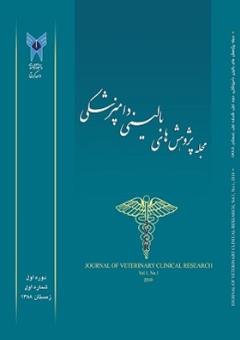Survey of gastrointestinal helminth fauna in dogs in the capital of Mazandaran province
Subject Areas : clinical veterinary science
morteza valinezhad
1
,
Fatemeh zahra Gharib
2
![]() ,
taher elmi
3
,
taher elmi
3
1 - . Resident of small animal internal medicine, Science and research branch, Islamic Azad University. Tehran, Iran.
2 - Department of clinical sciences,veterinary faculty, babol branch, islamic azad university, babol, iran
3 - Assistant professor, Department of laboratory science, Babol branch, Islamic Azad University, Babol, Iran
Keywords: Mazandaran, Helminth fauna, Zoonosis, Dog,
Abstract :
Due to not receiving proper treatment or not following the principles of animal shelter, dogs are at risk of contracting various infections, including parasitic ones. Some of the parasitic infections of dogs, including echinococcosis and toxocariasis, are a serious threat to human health due to their zoonosis, so in the present study, we examined the level of infection with gastrointestinal helminths in dogs in the capital of Mazandaran province. In this cross-sectional study, 120 stool samples The dog was collected from June 1400 to June 1401. After recording the dogs' characteristics, clinical symptoms and drug history, the stool samples were analyzed for the detection of parasitic worm eggs by direct method and formalin-ether. Finally, the data were statistically analyzed using SPSS version 22 software. The results showed that the infection with gastrointestinal parasites was 14.2%, in which Toxocara with a frequency of 5% and Hookworms with a frequency of 1.67% were the highest and the lowest percentage reported respectively. Also, the results showed that the contamination of gastrointestinal parasites in domestic dogs was significantly lower than in dogs from shelter (p<0.05). There is a significant prevalence and risks of common worms between humans and animals in domestic dogs and shelters in Mazandaran province. Therefore, understanding the epidemiology of zoonotic parasite infection is essential for access to health care for both domestic animals and human health.
1-Abbaszadeh Afshar MJ, Zahabiun F, Heydarian P, Mozafar Saadati H, Mohtasebi S, Khodamoradi F, et al. A systematic review and meta-analysis of toxocariasis in Iran: is it time to take it seriously? Acta Parasitologica. 2020;65:569-84.
2-Allam AF, Farag HF, Lotfy W, Fawzy HH, Elhadad H, Shehab AY. Comparison among FLOTAC, Kato-Katz and formalin ether concentration techniques for diagnosis of intestinal parasitic infections in school children in an Egyptian rural setting. Parasitology. 2021;148(3):289-94.
3- Amouei A, Jahandar H, Daryani A, Sharif M, Sarvi S, Mizani A, et al. Carnivores as important reservoirs of intestinal helminthic infections in Mazandaran Province, Northern Iran. Iranian Journal of Parasitology. 2018;13(2):251.
4- Ekong PS, Juryit R, Dika NM, Nguku P, Musenero M. Prevalence and risk factors for zoonotic helminth infection among humans and animals-Jos, Nigeria, 2005-2009. Pan African medical journal. 2012;12(1).
5- Elmi T, Gholami S, Rahimi-Esboei B, Garaili Z, Najm M, Tabatabaie F. Comparison of sensitivity of sucrose gradient, wet mount and formalin–ether in detecting protozoan giardia lamblia in stool specimens of BALB/c mice. J Pure Applied Microbiol. 2017;11:105-9.
6-. Ghafari A, Gharib FZ, Yousefi A. Frequency of Gastrointestinal Helminths Fauna among Dogs in Gorgan, Iran. J Gorgan Univ Med Sci. 2022; 24(3): 109-115.
7- Gharedaghi Y, Shabestari-Asl S, Hesam-Sadati R. A report on the alimentary canal helminthic infestation of stray and pet dogs in Tabriz. Veterinary Clinical Pathology The Quarterly Scientific Journal. 2008;2(2 (6) Summer):101-7.
8- Hassan MaM, Osman OF, El-Raba'a FM, Schallig HD, Elnaiem D-EA. Role of the domestic dog as a reservoir host of Leishmania donovani in eastern Sudan. Parasites & vectors. 2009;2:1-7.
9-. Idrissi a H, El Hamiani Khatat b S, Duchateau c L, Kachani d M.Prevalence, risk factors and zoonotic potential of intestinal parasites in dogs from four locations in Morocco.Veterinary Parasitology: Regional Studies and Reports.2022;Vol:34,100775.
10- Mbong Ngwese M, Prince Manouana G, Nguema Moure PA, Ramharter M, Esen M, Adégnika AA. Diagnostic techniques of soil-transmitted helminths: impact on control measures. Tropical Medicine and Infectious Disease. 2020;5(2):93.
11- Othman RA, Abuseir S. The prevalence of gastrointestinal parasites in native dogs in Palestine. Iranian Journal of Parasitology. 2021;16(3):435.
12- Papazahariadou M, Founta A, Papadopoulos E, Chliounakis S, Antoniadou-Sotiriadou K, Theodorides Y. Gastrointestinal parasites of shepherd and hunting dogs in the Serres Prefecture, Northern Greece. Veterinary Parasitology. 2007;148(2):170-3.
13- Parija S, Bhattacharya S, Padhan P, Shivaprakash M. Evaluation of Formalin—Acetone Sedimentation in the Concentration of Stool for Intestinal Parasites. Tropical doctor. 2003;33(3):163-4.
14- Rahmati K, Maghsoud AH, Matini M, Motevalli Haghi M, Fallah N, Fallah M. Study of Intestinal helminthes of stray dogs and their public heath importance in Hamadan city. Avicenna Journal of Clinical Medicine. 2016;23(3):214-20.
15- Raza A, Rand J, Qamar AG, Jabbar A.,Kopp S. Gastrointestinal parasites in shelter dogs: occurrence, pathology, treatment and risk to shelter workers Animals,2018;8:p.108, 10.3390/ani8070108.
16- Sanpool O, Intapan P, Rodpai R, Laoraksawong P, Sadaow L, Tourtip S, et al. Dogs are reservoir hosts for possible transmission of human strongyloidiasis in Thailand: molecular identification and genetic diversity of causative parasite species. Journal of helminthology. 2020;94:e110.
17- Sharifdini M, Ghanbarzadeh L, Kouhestani-Maklavani N, Mirjalali H, Saraei M. Prevalence and molecular aspects of human hookworms in Guilan province, northern Iran. Iranian Journal of Parasitology. 2017;12(3):374.
18- Siyadatpanah A, Pagheh AS, Daryani A, Sarvi S, Hosseini SA, Norouzi R, et al. Parasitic helminth infections of dogs, wolves, foxes, and golden jackals in Mazandaran Province, North of Iran. Veterinary World. 2020;13(12):2643.
19- Sobotyk C, Upton KE, Lejeune M, Nolan TJ, Marsh AE, Herrin BH, et al. Retrospective study of canine endoparasites diagnosed by fecal flotation methods analyzed across veterinary parasitology diagnostic laboratories, United States, 2018. Parasites & Vectors. 2021;14(1):439.
20- Truant AL, Elliott SH, Kelly MT, Smith JH. Comparison of formalin-ethyl ether sedimentation, formalin-ethyl acetate sedimentation, and zinc sulfate flotation techniques for detection of intestinal parasites. Journal of clinical microbiology. 1981;13(5):882-4.


